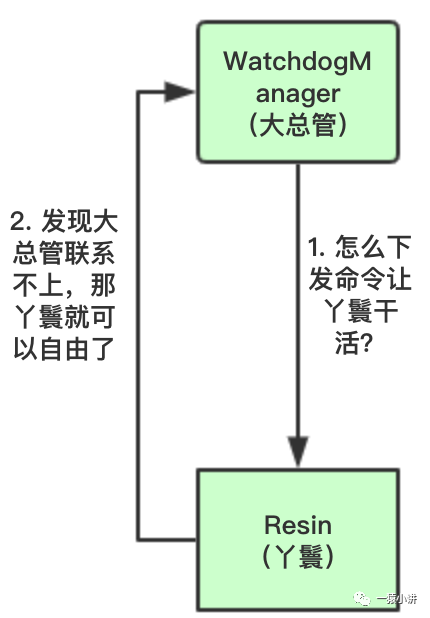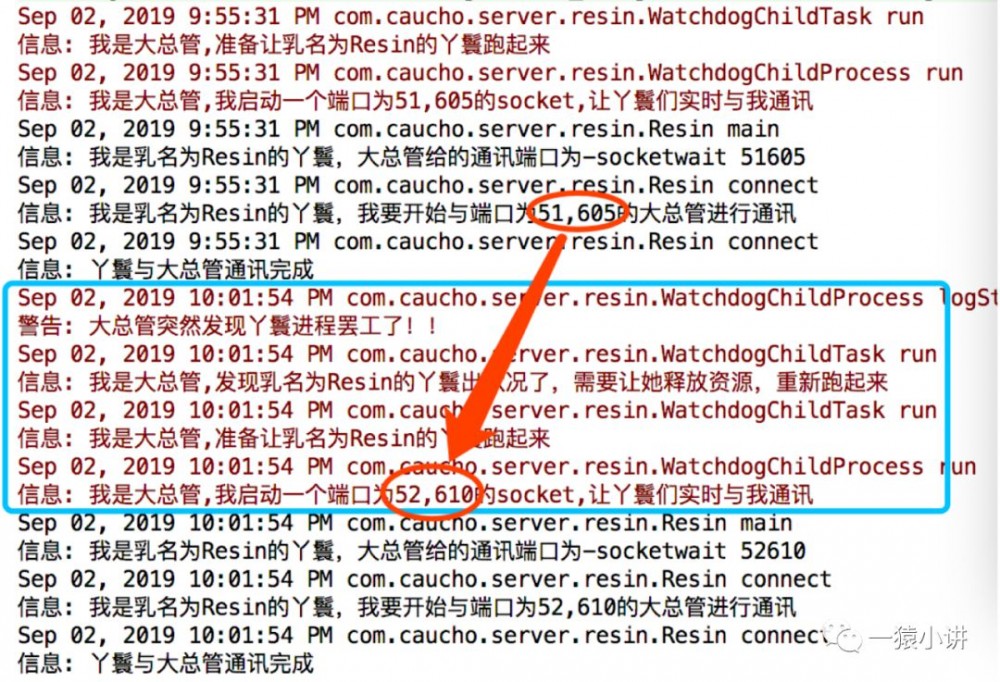如何让Java应用成为杀不死的小强?(下篇)
【这是一猿小讲的第 49 篇原创分享】
各位坐稳扶好,我们要开车了。不过在开车之前,我们还是例行回顾一下上期分享的要点。
经过前两期的铺垫及烧脑的分享,我们大概对「 如何实现 Java 应用进程的状态监控,如果被监控的进程 down 掉,是否有机制能启动起来? 」问题本身有了一个新的认识,那这期我们不妨拿出攻城狮的绝招 Ctrl + C、Ctrl + V,从 Resin 源码中摘取一二,稍微简单实践一下。

按照图示,咱们先演示一下实践效果吧,首先找到并运行程序入口 MonitorApp,日志输出如下。

此时我们不妨在控制台输入 jps 命令,看一看效果。
18830 MonitorApp
18831 Resin
发现成功启动了 MonitorApp、Resin 两个进程,和 Resin 应用服务器是一模一样的,如果我们把进程号为 18831 的 kill 掉,会是什么效果?发现控制台日志输出又多了一些,貌似丫鬟 Resin 又被重新给启动了。

在控制台输入 jps 命令再确认一下是否真的变了。
18830 MonitorApp
18935 Resin
那我们到底该如何实现? 那不妨照葫芦画瓢,模仿一下 Resin 的实现一下(这就是绝招: 仿一仿)。
首先定义我们的监控应用入口 MonitorApp,很简单就是把创建子进程的任务给启动起来。
package com.caucho.server.resin;
public class MonitorApp {
public static void main(String[] args) {
new WatchdogChildTask().start();
}
}
接下来再编写 WatchdogChildTask 子进程任务的代码,大部分来源于 Resin 的源码,只是剔除了很多很多很多,简化了很多很多很多。 仔细看发现也很简单,就有一个循环一直调用 WatchdogChildProcess 的 run 方法,目的也就是一直让丫鬟进程跑起来。
package com.caucho.server.resin;
import java.util.concurrent.Executors;
import java.util.logging.Level;
import java.util.logging.Logger;
class WatchdogChildTask implements Runnable {
private static final Logger log = Logger.getLogger(WatchdogChildTask.class.getName());
private WatchdogChildProcess _process;
/**
* Starts management of the watchdog process
*/
public void start() {
//TODO 手动创建线程池会更好 【阿里开发规约】
Executors.newFixedThreadPool(1).execute(this);
}
/**
* Main thread watching over the health of the Resin instances.
*/
public void run() {
try {
int i = 0;
long retry = Long.MAX_VALUE;
while (i++ < retry) {
WatchdogChildProcess process = new WatchdogChildProcess();
_process = process;
try {
log.log(Level.INFO, "我是大总管,准备让乳名为Resin的丫鬟跑起来");
_process.run();
} catch (Exception e) {
log.log(Level.WARNING, e.toString(), e);
} finally {
_process = null;
if (process != null) {
log.log(Level.INFO, "我是大总管,发现乳名为Resin的丫鬟出状况了,需要让她释放资源,重新跑起来");
process.kill();
}
}
}
} catch (Exception e) {
log.log(Level.WARNING, e.toString(), e);
} finally {
if (_process != null) {
_process.kill();
_process = null;
}
}
}
}
具体是怎么把丫鬟进程跑起来的,这个事情专门交给 WatchdogChildProcess 去做了,先启动了一个 socket 通讯端口;然后采用 ProcessBuilder 启动 Resin 进程;然后等待丫鬟进程建立 socket 连接通讯。大部分也是来源于 Resin 的源码,只不过做了大量删减。另外重点提一嘴:拿下去只需修改 com.caucho.server.resin.Resin 为你要监控应用的主函数即可。
package com.caucho.server.resin;
import java.io.*;
import java.net.*;
import java.util.*;
import java.util.concurrent.atomic.AtomicReference;
import java.util.logging.Level;
import java.util.logging.Logger;
class WatchdogChildProcess {
private static final Logger log = Logger.getLogger(WatchdogChildProcess.class.getName());
private Socket _childSocket;
private OutputStream _stdOs;
private int _status = -1;
private AtomicReference<Process> _processRef = new AtomicReference<Process>();
public void run() {
ServerSocket ss = null;
Socket s = null;
try {
ss = new ServerSocket(0, 5, InetAddress.getByName("127.0.0.1"));
int port = ss.getLocalPort();
log.log(Level.INFO, "我是大总管,我启动一个端口为{0}的socket,让丫鬟们实时与我通讯",port);
Process process = createProcess(port);
if (process != null) {
_processRef.compareAndSet(null, process);
InputStream stdIs = process.getInputStream();
_stdOs = process.getOutputStream();
//TODO 不要显式创建线程,请使用线程池【阿里开发规约】
new Thread(new WatchdogProcessLogThread(stdIs)).start();
s = connectToChild(ss);
_status = process.waitFor();
logStatus(_status);
}
} catch (Exception e) {
log.log(Level.WARNING, e.toString(), e);
try {
Thread.sleep(5000);
} catch (Exception e1) {
}
} catch (Throwable e) {
log.log(Level.WARNING, e.toString(), e);
} finally {
if (ss != null) {
try {
ss.close();
} catch (Throwable e) {
}
}
try {
if (s != null) {
s.close();
}
} catch (Throwable e) {
log.log(Level.FINER, e.toString(), e);
}
kill();
synchronized (this) {
notifyAll();
}
}
}
private void logStatus(int status) {
String code = " (exit code=" + status + ")";
log.warning("大总管突然发现丫鬟进程罢工了!!");
}
void kill() {
Process process = _processRef.getAndSet(null);
if (process != null) {
try {
process.destroy();
} catch (Exception e) {
log.log(Level.FINE, e.toString(), e);
}
}
OutputStream stdOs = _stdOs;
_stdOs = null;
if (stdOs != null) {
try {
stdOs.close();
} catch (Throwable e) {
log.log(Level.FINE, e.toString(), e);
}
}
Socket childSocket = _childSocket;
_childSocket = null;
if (childSocket != null) {
try {
childSocket.close();
} catch (Throwable e) {
log.log(Level.FINE, e.toString(), e);
}
}
if (process != null) {
try {
process.waitFor();
} catch (Exception e) {
log.log(Level.INFO, e.toString(), e);
}
}
}
/**
* Waits for a socket connection from the child, returning the socket
*
* @param ss TCP ServerSocket from the watchdog for the child to connect to
*/
private Socket connectToChild(ServerSocket ss)
throws IOException {
Socket s = null;
try {
ss.setSoTimeout(60000);
for (int i = 0; i < 120 && s == null; i++) {
try {
s = ss.accept();
} catch (SocketTimeoutException e) {
}
}
if (s != null) {
_childSocket = s;
}
} catch (Exception e) {
log.log(Level.WARNING, e.toString(), e);
} finally {
ss.close();
}
return s;
}
/**
* Creates a new Process for the Resin JVM, initializing the environment
* and passing value to the new process.
*
* @param socketPort the watchdog socket port
* @param out the debug log jvm-default.log
*/
private Process createProcess(int socketPort)
throws IOException {
HashMap<String, String> env = buildEnv();
ArrayList<String> jvmArgs = buildJvmArgs();
jvmArgs.add("com.caucho.server.resin.Resin");
jvmArgs.add("-socketwait");
jvmArgs.add(String.valueOf(socketPort));
ProcessBuilder builder = new ProcessBuilder();
builder.environment().putAll(env);
builder = builder.command(jvmArgs);
builder.redirectErrorStream(true);
return builder.start();
}
private HashMap<String, String> buildEnv()
throws IOException {
HashMap<String, String> env = new HashMap<String, String>();
env.putAll(System.getenv());
StringBuilder classPath = new StringBuilder();
// TODO 系统不一样分割符也不同 windows为分号;
classPath.append(".:");
String appPath = System.getProperty("user.dir");
classPath.append(appPath).append("/resin/target/classes");
env.put("CLASSPATH", classPath.toString());
// 。。。删除了可多可多的代码 。。。
return env;
}
private ArrayList<String> buildJvmArgs() {
ArrayList<String> jvmArgs = new ArrayList<String>();
jvmArgs.add("java");
// ... 又删除了可多代码 ...
return jvmArgs;
}
/**
* Watchdog thread responsible for writing jvm-default.log by reading the
* JVM's stdout and copying it to the log.
*/
class WatchdogProcessLogThread implements Runnable {
private InputStream _is;
/**
* @param is the stdout stream from the Resin
*/
WatchdogProcessLogThread(InputStream is) {
_is = is;
}
@Override
public void run() {
try {
int len;
byte[] data = new byte[4096];
while ((len = _is.read(data, 0, data.length)) > 0) {
System.out.print(new String(data, 0, len));
}
} catch (Throwable e) {
log.log(Level.WARNING, e.toString(), e);
} finally {
kill();
}
}
}
}
下面这个要重点说下,因为这套模型你拿过去,只需修改下面 Resin 这个类的代码,这个其实也就是我们要监控的应用。 其实很简单,就有一个 connect 方法主要用于与大总管进行通讯,一旦通讯失败本身就退出。
package com.caucho.server.resin;
import java.io.IOException;
import java.io.InputStream;
import java.net.Socket;
import java.util.concurrent.ExecutorService;
import java.util.concurrent.Executors;
import java.util.logging.Level;
import java.util.logging.Logger;
public class Resin {
private static ExecutorService executorService = Executors.newFixedThreadPool(1);
private static final Logger log = Logger.getLogger(Resin.class.getName());
public static void main(String[] args) {
log.log(Level.INFO, "我是乳名为Resin的丫鬟,大总管给的通讯端口为{0} {1}", args);
//获取传入的参数 port
int port = Integer.parseInt(args[1]);
connect(port);
}
public static void connect(final int port) {
log.log(Level.INFO, "我是乳名为Resin的丫鬟,我要开始与端口为{0}的大总管进行通讯",port);
executorService.execute(new Runnable() {
@Override
public void run() {
Socket socket = null;
try {
socket = new Socket("127.0.0.1", port);
InputStream s = socket.getInputStream();
byte[] buf = new byte[1024];
int len;
while ((len = s.read(buf)) != -1) {
log.log(Level.INFO, "通讯信息 {0}", new String(buf, 0, len));
}
} catch (IOException e) {
log.log(Level.WARNING, "我是乳名为Resin的丫鬟,与端口为{0}的大总管进行通讯发生异常",port);
} finally {
try {
socket.close();
} catch (IOException e) {
log.log(Level.WARNING, e.getMessage(), e);
}
log.log(Level.INFO, "我是乳名为Resin的丫鬟,与端口为{0}的大总管进行通讯结束,我要退下啦",port);
System.exit(0);
}
}
});
log.log(Level.INFO, "丫鬟与大总管通讯完成");
}
}
到这,代码也就码完了,不妨把代码拔下去,运行一下,稍微体验体验,看看是不是那回事儿! 其中为了演示需要删除了 N 多代码,有些地方很不优雅,还需按照阿里开发规约适当调整调整,不过这些不是咱们这期分享的重点,咱们重点是思想 + 轻实践。
好了,思想也落地了,接下来就看你怎么让它老树开新花啦。 分享就到这儿吧,希望能够解你所惑; 希望能在你前进的道路上,帮你披荆斩棘。 如果感觉有点帮助,欢迎在看、秒赞,疯狂分享转发,因为你的每一次分享,我都认真当成了鼓励与喜欢。

推荐阅读:
老技术新谈,Java应用监控利器JMX(1)
老技术新谈,Java应用监控利器JMX(2)
老技术新谈,Java应用监控利器JMX(3)
一篇文章讲透线上应用监控
- 本文标签: App src windows Property map ArrayList 参数 java 文章 希望 TCP stream build 源码 Atom cat HashMap list 删除 https IO 代码 retry Connection classpath message 进程 bug value http db executor IDE synchronized final ssl 线程池 线程 模型 parse ask 端口 Service UI JVM 开发 服务器 Logging tar id
- 版权声明: 本文为互联网转载文章,出处已在文章中说明(部分除外)。如果侵权,请联系本站长删除,谢谢。
- 本文海报: 生成海报一 生成海报二











![[HBLOG]公众号](https://www.liuhaihua.cn/img/qrcode_gzh.jpg)

